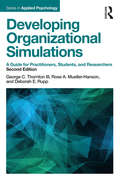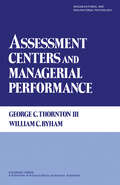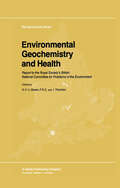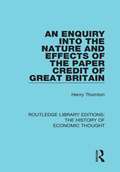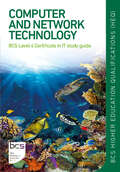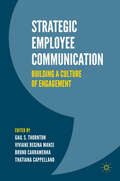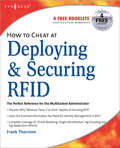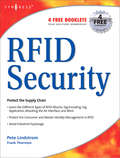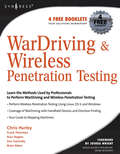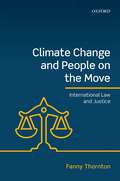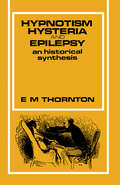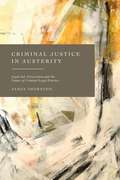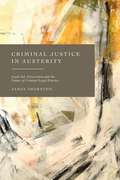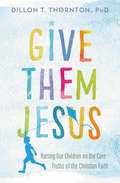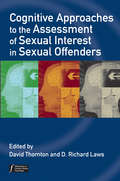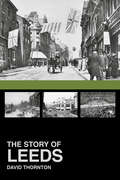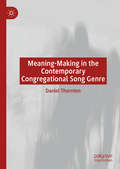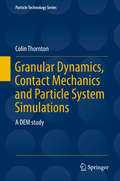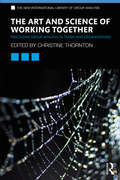- Table View
- List View
Developing Organizational Simulations: A Guide for Practitioners, Students, and Researchers (Applied Psychology Series)
by George C. Thornton III Rose A. Mueller-Hanson Deborah E. RuppThis second edition of Developing Organizational Simulations provides a concise source of information on effective and practical methods for constructing simulation exercises for the assessment of psychological characteristics relevant to effectiveness in work organizations. Incorporating new additions such as the multiple ways technology can be used in the design, delivery, scoring, and evaluating of simulation exercises, as well as the delivery of feedback based on the results, this book is user-friendly with practical how-to guidance, including many graphics, boxes, and examples. This book is ideal for practitioners, consultants, HR specialists, students, and researchers in need of guidance developing organizational simulations for personnel selection, promotion, diagnosis, training, or research. It is also suited for courses, workshops, and training programs in testing and measurement, personnel selection, training and development, and research methodology.
Developing Organizational Simulations: A Guide for Practitioners, Students, and Researchers (Applied Psychology Series)
by George C. Thornton III Rose A. Mueller-Hanson Deborah E. RuppThis second edition of Developing Organizational Simulations provides a concise source of information on effective and practical methods for constructing simulation exercises for the assessment of psychological characteristics relevant to effectiveness in work organizations. Incorporating new additions such as the multiple ways technology can be used in the design, delivery, scoring, and evaluating of simulation exercises, as well as the delivery of feedback based on the results, this book is user-friendly with practical how-to guidance, including many graphics, boxes, and examples. This book is ideal for practitioners, consultants, HR specialists, students, and researchers in need of guidance developing organizational simulations for personnel selection, promotion, diagnosis, training, or research. It is also suited for courses, workshops, and training programs in testing and measurement, personnel selection, training and development, and research methodology.
Assessment Centers and Managerial Performance (Organizational and Occupational Psychology)
by George C. Thornton III William C. ByhamAssessment Centers and Managerial Performance presents the historical development of multiple assessment procedures with focus on those advances relevant to assessment centers. This book discusses the models of job analysis, the nature of managerial work, work-sampling assessment methods, and the process of human judgment based on the assessment center experience. Organized into 11 chapters, this book begins with an overview of the various methods to describe, evaluate, and predict management effectiveness. This text then describes a number of assessment programs, including the earliest assessment centers. Other chapters consider the five approaches to predicting managerial effectiveness, including psychometric testing, clinical evaluations by psychologists, supervisor's ratings of potentials background interviews, and assessment centers. This book discusses as well the three levels of managerial jobs, namely, supervisory, middle management, and executive. The final chapter deals with the development of standards for assessment center operations. This book is a valuable resource for psychologists.
Environmental Geochemistry and Health: Report to the Royal Society’s British National Committee for Problems of the Environment (GeoJournal Library #2)
by I. Thornton S. H. U.BowieOne of the main outcomes of the eleven meetings of the Working Party was the recognition of the importance of interdisciplinary studies linking regional geochemistry with plant, animal and human health. The effects of major element deficiencies or excesses on plant health are well known; this is not the case for trace elements. In fact, rapid and reliable analytical methods for determining trace element abundances have only recently become available, and it is to be expected that important new information on trace element levels will be forthcoming. This, however, is only part of the problem because other factors such as element speciation, uptake and transmission may be more significant than total concentration. The pathways of elements from crops to animals are relatively well defined, but the aetiology of diseases attributable to elemental inadequacies or excesses is generally quite complex. Nevertheless, there is good evidence for diseases in livestock in the British Isles induced by deficiencies of Cu, Se and Co and Mo excess. On a world scale there is also convincing data on the effect of Na, P and I deficiencies and F excess on animal health. What is generally lacking, however, is adequate interaction between geochemists and biochemists, veterinary scientists and other concerned with animal health. Interpretation of geochemical data is complex as are connections between elemental abundances and the health of animals.
An Enquiry into the Nature and Effects of the Paper Credit of Great Britain (Routledge Library Editions: The History of Economic Thought)
by Henry ThorntonThis book, first edited with an introduction by F. A. v. Hayek in 1939, explores some of the popular errors which related to the suspension of the cash payments of the Bank of England, and to the influence of our paper currency on the price of provisions. The introduction provides an interesting overview of the life, thoughts, and achievements of Henry Thornton. An Enquiry into the Nature and Effects of the Paper Credit of Great Britain will be of interest to students of the history of economic thought.
An Enquiry into the Nature and Effects of the Paper Credit of Great Britain (Routledge Library Editions: The History of Economic Thought)
by Henry ThorntonThis book, first edited with an introduction by F. A. v. Hayek in 1939, explores some of the popular errors which related to the suspension of the cash payments of the Bank of England, and to the influence of our paper currency on the price of provisions. The introduction provides an interesting overview of the life, thoughts, and achievements of Henry Thornton. An Enquiry into the Nature and Effects of the Paper Credit of Great Britain will be of interest to students of the history of economic thought.
Yoga Therapy for Children and Teens with Complex Needs: A Somatosensory Approach to Mental, Emotional and Physical Wellbeing
by Shawnee Thornton Thornton HardyThis deeply compassionate and inclusive resource explores the practice of yoga therapy, mindfulness, and somatic enquiry with children and young people who have complex needs. Suitable for working with ages 5-18, the book explores a wide range of conditions, including sensory processing disorder, autism, Down syndrome, hypermobility, scoliosis, anxiety, depression, and trauma.Chapters also include comprehensive theory on the nervous system, child development from the age of 3+, the benefits of expressive arts, and regular reflective prompts for the adults. It is supplemented with over 100 photographs to ease learning and is an invaluable resource for therapists working with children and teens with complex needs.
Yoga Therapy for Children and Teens with Complex Needs: A Somatosensory Approach to Mental, Emotional and Physical Wellbeing
by Shawnee Thornton Thornton HardyThis deeply compassionate and inclusive resource explores the practice of yoga therapy, mindfulness, and somatic enquiry with children and young people who have complex needs. Suitable for working with ages 5-18, the book explores a wide range of conditions, including sensory processing disorder, autism, Down syndrome, hypermobility, scoliosis, anxiety, depression, and trauma.Chapters also include comprehensive theory on the nervous system, child development from the age of 3+, the benefits of expressive arts, and regular reflective prompts for the adults. It is supplemented with over 100 photographs to ease learning and is an invaluable resource for therapists working with children and teens with complex needs.
Computer and Network Technology: BCS Level 4 Certificate in IT study guide
by Gary Thornton Carl JonesThis interactive study guide will support candidates in developing fundamental knowledge and understanding of the basics of computer and network technology, processor architecture and networks, and with an introduction to operating systems and system oftware. It explains key concepts within the Computer and Network Technology module and helps candidates prepare for their exams, including explainer videos, interactive questions and skills challenges aligned to the syllabus and with industry practice.
Strategic Employee Communication: Building a Culture of Engagement
by Gail S. Thornton Viviane Regina Mansi Bruno Carramenha Thatiana CappellanoEmployee engagement (or a lack thereof) can often be linked to poor communication and a detachment from company goals. Companies of all sizes are looking for ways to boost communication, recognizing its impact on key business outcomes, such as productivity and profitability. This book offers fresh insights about opportunities to improve the quality of employee communications based on employees’ needs. It highlights the importance of simple, jargon-free communication that focuses on dialogue and content. High-performing organizations are more likely to think about communication from the audience perspective, rather than purely from the management perspective. The case studies offer readers a firm understanding of ways to implement and measure communication in daily practice. Effective communication requires planning and this book, with its focus on the US, Latin America, and emerging markets, will guide readers in using communication in the alignment of corporate and employee needs.
How to Cheat at Deploying and Securing RFID (How to Cheat)
by Frank Thornton Paul SangheraRFID is a method of remotely storing and receiving data using devices called RFID tags. RFID tags can be small adhesive stickers containing antennas that receive and respond to transmissions from RFID transmitters. RFID tags are used to identify and track everything from Exxon EZ pass to dogs to beer kegs to library books. Major companies and countries around the world are adopting or considering whether to adopt RFID technologies. Visa and Wells Fargo are currently running tests with RFID, airports around the world are using RFID to track cargo and run customs departments, universities such as Slippery Rock are providing RFID-enabled cell phones for students to use for campus charges. According to the July 9 CNET article, RFID Tags: Big Brother in Small Packages?, "You should become familiar with RFID technology because you'll be hearing much more about it soon. Retailers adore the concept, and CNET News.com's own Alorie Gilbert wrote last week about how Wal-Mart and the U.K.-based grocery chain Tesco are starting to install "smart shelves" with networked RFID readers. In what will become the largest test of the technology, consumer goods giant Gillette recently said it would purchase 500 million RFID tags from Alien Technology of Morgan Hill, CA." For security professionals needing to get up and running fast with the topic of RFID, this How to Cheat approach to the topic is the perfect "just what you need to know" book!* For most business organizations, adopting RFID is a matter of when* The RFID services market is expected to reach $4 billion by 2008* Covers vulnerabilities and personal privacy--topics identified by major companies as key RFID issues
RFID Security
by Frank Thornton Chris LanthemRFID is a method of remotely storing and receiving data using devices called RFID tags. RFID tags can be small adhesive stickers containing antennas that receive and respond to transmissions from RFID transmitters. RFID tags are used to identify and track everything from food, dogs, beer kegs to library books. RFID tags use a standard that has already been hacked by several researchers. RFID Security discusses the motives for someone wanting to hack an RFID system and shows how to protect systems. Coverage includes: security breaches for monetary gain (hacking a shops RFID system would allow a hacker to lower the pricing on any product products). How to protect the supply chain (malicous/mischievous hackers can delete/alter/modify all identifying information for an entire shipment of products). How to protect personal privacy (privacy advocates fear that RFID tags embedded in products, which continue to transmit information after leaving a store, will be used to track consumer habits).The purpose of an RFID system is to enable data to be transmitted by a portable device, called a tag, which is read by an RFID reader and processed according to the needs of a particular application. The data transmitted by the tag may provide identification or location information, or specifics about the product tagged, such as price, colour, date of purchase, etc. .* Deloitte & Touche expects over 10 billion RFID tags to be in circulation by the end of 2005 * Parties debating the security issue of RFID need information on the pros and cons of the technology and this is that information* Little competition in a market desperate for information
WarDriving and Wireless Penetration Testing
by Frank Thornton Brian Baker Chris Hurley Russ RogersWireless networking has become standard in many business and government networks. This book is the first book that focuses on the methods used by professionals to perform WarDriving and wireless pentration testing.Unlike other wireless networking and security books that have been published in recent years, this book is geared primarily to those individuals that are tasked with performing penetration testing on wireless networks. This book continues in the successful vein of books for penetration testers such as Google Hacking for Penetration Testers and Penetration Tester’s Open Source Toolkit. Additionally, the methods discussed will prove invaluable for network administrators tasked with securing wireless networks. By understanding the methods used by penetration testers and attackers in general, these administrators can better define the strategies needed to secure their networks.* According to a study by the Strategis Group more than one third of the words population will own a wireless device by the end of 2008. * The authors have performed hundreds of wireless penetration tests, modeling their attack methods after those used by real world attackers. * Unlike other wireless books, this is geared specifically for those individuals that perform security assessments and penetration tests on wireless networks.
Climate Change and People on the Move: International Law and Justice
by Fanny ThorntonThis book applies a justice framework to analysis of the actual and potential role of international law with respect to people on the move in the context of anthropogenic climate change. That people are affected by the impacts of climate change is no longer doubted, including with implications for people movement (migration, displacement, relocation, etc.). Climate Change and People on the Move tackles unique questions concerning international responsibility for people movement arising from the inequities inherent to climate change. Corrective and distributive justice provide the analytical backbone, and are explored in a substantial theoretical chapter and then applied to subsequent contextual analysis. Corrective justice supports analysis as to whether people movement in the climate change context could be conceived or framed as harm, loss, or damage which is compensable under international law, either through fault-centred regimes or no-fault regimes (i.e. insurance). Distributive justice supports analysis as to whether such movement could be conceived or framed as a disproportionate burden, either for those faced with movement or those faced with sheltering people on the move, from which duties of re-distribution may stem. This book contributes to the growing scholarship and analysis concerning international law or governance and people movement in response to the impacts of climate change by investigating the bounds of the law where the phenomenon is viewed as one of (in)justice.
Climate Change and People on the Move: International Law and Justice
by Fanny ThorntonThis book applies a justice framework to analysis of the actual and potential role of international law with respect to people on the move in the context of anthropogenic climate change. That people are affected by the impacts of climate change is no longer doubted, including with implications for people movement (migration, displacement, relocation, etc.). Climate Change and People on the Move tackles unique questions concerning international responsibility for people movement arising from the inequities inherent to climate change. Corrective and distributive justice provide the analytical backbone, and are explored in a substantial theoretical chapter and then applied to subsequent contextual analysis. Corrective justice supports analysis as to whether people movement in the climate change context could be conceived or framed as harm, loss, or damage which is compensable under international law, either through fault-centred regimes or no-fault regimes (i.e. insurance). Distributive justice supports analysis as to whether such movement could be conceived or framed as a disproportionate burden, either for those faced with movement or those faced with sheltering people on the move, from which duties of re-distribution may stem. This book contributes to the growing scholarship and analysis concerning international law or governance and people movement in response to the impacts of climate change by investigating the bounds of the law where the phenomenon is viewed as one of (in)justice.
Hypnotism, Hysteria and Epilepsy: An Historical Synthesis
by E. M. ThorntonHypnotism, Hysteria, and Epilepsy: An Historical Synthesis focuses on processes, advancements, and applications of hypnotism and studies on hysteria and epilepsy. The publication first underscores the influence of Franz Anton Mesmer on the spread of hypnotism, as well as the contributions of John Hughlings Jackson on the study of epilepsy. The book also ponders on the use of magnetism in Paris hospitals and lucid somnambule. The text takes a look at the developments in hypnotism, epilepsy, and hysteria in Germany, including the influence of magnetism on the intellectual life of the country, the Odylic Force, and the use of magnetism on Friedericke Hauffe. The book also expounds on the transition from magnetism to hypnotism. Discussions focus on phrenomagnetism, animal experiments, famous somnambulists, occultism and spiritualism, increasing use of fraud, and decline of magnetism. Speech and command automatism and artificial hallucinations are also discussed. The publication is a valuable source of data for readers interested in the relationships of hypnotism, hysteria, and epilepsy.
Criminal Justice in Austerity: Legal Aid, Prosecution and the Future of Criminal Legal Practice
by Dr James ThorntonThis book offers a timely and detailed examination of the reality of criminal legal practice today. Drawing upon extensive anonymous interviews with criminal lawyers in England and Wales, it illuminates how financial pressures arise within the criminal justice system and how lawyers seek to navigate them.The work of criminal lawyers is frequently depicted in the news and media as exciting, well-paid and worthwhile, with prosecutors aiming to convict the guilty and defence lawyers fighting against miscarriages of justice. In contrast, the picture reported by many is of an already creaking and under-resourced system, now exacerbated by fallout from the COVID-19 pandemic. Against this backdrop, the book considers whether the criminal legal aid system really can continue to provide those unable to afford a lawyer with access to justice and whether the Crown Prosecution Service can provide justice to victims of crime. The book presents detailed findings about the work and experiences of both prosecutors and defence lawyers, how financial pressures influence this and to what extent this has changed with the new ways of working brought about by the COVID-19 pandemic.
Criminal Justice in Austerity: Legal Aid, Prosecution and the Future of Criminal Legal Practice
by Dr James ThorntonThis book offers a timely and detailed examination of the reality of criminal legal practice today. Drawing upon extensive anonymous interviews with criminal lawyers in England and Wales, it illuminates how financial pressures arise within the criminal justice system and how lawyers seek to navigate them.The work of criminal lawyers is frequently depicted in the news and media as exciting, well-paid and worthwhile, with prosecutors aiming to convict the guilty and defence lawyers fighting against miscarriages of justice. In contrast, the picture reported by many is of an already creaking and under-resourced system, now exacerbated by fallout from the COVID-19 pandemic. Against this backdrop, the book considers whether the criminal legal aid system really can continue to provide those unable to afford a lawyer with access to justice and whether the Crown Prosecution Service can provide justice to victims of crime. The book presents detailed findings about the work and experiences of both prosecutors and defence lawyers, how financial pressures influence this and to what extent this has changed with the new ways of working brought about by the COVID-19 pandemic.
Give Them Jesus: Raising Our Children on the Core Truths of the Christian Faith
by Dillon T. ThorntonA fresh, clear, joyful guide for parents on how to teach their children to love God with all their heart, soul, mind, and strength.Give Them Jesus aims to help parents not simply add to their children's stockpile of knowledge, but to cultivate children-disciples who are able to display Christ-likeness in every situation. Parents are the ones primarily responsible for opening up the Scriptures to help their children understand God, the world, and themselves. The family is the divinely appointed discipleship program; the home is first and foremost a place of worship. The introduction of the book discusses the four vital components of family worship: teach, treasure, sing, and pray, and offers practical suggestions for beginning and prioritizing family worship in the rough and tumble of life. Subsequent chapters guide parents to a deeper understanding of the core truths of the historic Christian faith, as summarized in the Apostles' Creed, arming them with appropriate language, helpful illustrations, and relevant object lessons, so that in the end they will be better prepared to pass these truths on to their children. Each chapter concludes with a family worship guide, which includes: 1) family memory verses, 2) nuggets of truth from the chapter, 3) questions for family discussion, 4) songs that celebrate the truths of the Creed, and 5) prayer prompts. Give Them Jesus equips parents to prepare their children to leave home and go out into the world as faithful participants in the great gospel story. "Never stop telling the gospel story to your kids," Thornton says. "Give your children Jesus. Again. And again. And again. And you'll see them walk in the truth."
Cognitive Approaches to the Assessment of Sexual Interest in Sexual Offenders (Wiley Series in Forensic Clinical Psychology)
by David Thornton D. Richard LawsNew for the Wiley Series in Forensic Clinical Psychology, Cognitive Approaches to the Treatment of Sexual Offenders describes and evaluates the current methods of measuring sexual interest in sex offenders - namely penile plethysmography, the Abel Assessment for Sexual Interest, Affinity 2.1, the Implicit Association Test, the Stroop test and the polygraph. The book also discusses how established cognitive assessment methods such as the attentional blink and the startle probe reflex can be adapted for use with sex offenders. It therefore brings together in one volume all the latest research and practice in this area, along with critical commentary on the effectiveness of each method.
The Story of Leeds
by David ThorntonA richly illustrated history that explores every aspect of life in Leeds. This new history of Leeds covers all the main political, social and economic developments of the city: The Harrying of the North devastated the surrounding area in 1069; the Civil War saw a battle fought in the town itself; cholera and typhus epidemics raged in the nineteenth century; the building of the Middleton Railway in 1758 established the oldest railway in the world; and Richard Oastler, the Factory King, launched the campaign for the Ten Hour Bill in the Leeds Mercury. Due emphasis is given to the place of the wool textile industry, the principal industry until the twentieth century. The story is brought right up to date, as are recent changes in the townscape. An intriguing look at this great city’s remarkable history.
Meaning-Making in the Contemporary Congregational Song Genre
by Daniel ThorntonThis book analyses the most sung contemporary congregational songs (CCS) as a global music genre. Utilising a three-part music semiology, this research engages with producers, musical texts, and audiences/congregations to better understand contemporary worship for the modern church and individual Christians. Christian Copyright Licensing International data plays a key role in identifying the most sung CCS, while YouTube mediations of these songs and their associated data provide the primary texts for analysis. Producers and the production milieu are explored through interviews with some of the highest profile worship leaders/songwriters including Ben Fielding, Darlene Zschech, Matt Redman, and Tim Hughes, as well as other music industry veterans. Finally, National Church Life Survey data and a specialized survey provide insight into individual Christians’ engagement with CCS. Daniel Thornton shows how these perspectives taken together provide unique insight into the current global CCS genre, and into its possible futures.
Granular Dynamics, Contact Mechanics and Particle System Simulations: A DEM study (Particle Technology Series #24)
by Colin ThorntonThis book is devoted to the Discrete Element Method (DEM) technique, a discontinuum modelling approach that takes into account the fact that granular materials are composed of discrete particles which interact with each other at the microscale level. This numerical simulation technique can be used both for dispersed systems in which the particle-particle interactions are collisional and compact systems of particles with multiple enduring contacts. The book provides an extensive and detailed explanation of the theoretical background of DEM. Contact mechanics theories for elastic, elastic-plastic, adhesive elastic and adhesive elastic-plastic particle-particle interactions are presented. Other contact force models are also discussed, including corrections to some of these models as described in the literature, and important areas of further research are identified. A key issue in DEM simulations is whether or not a code can reliably simulate the simplest of systems, namely the single particle oblique impact with a wall. This is discussed using the output obtained from the contact force models described earlier, which are compared for elastic and inelastic collisions. In addition, further insight is provided for the impact of adhesive particles. The author then moves on to provide the results of selected DEM applications to agglomerate impacts, fluidised beds and quasi-static deformation, demonstrating that the DEM technique can be used (i) to mimic experiments, (ii) explore parameter sweeps, including limiting values, or (iii) identify new, previously unknown, phenomena at the microscale. In the DEM applications the emphasis is on discovering new information that enhances our rational understanding of particle systems, which may be more significant than developing a new continuum model that encompasses all microstructural aspects, which would most likely prove too complicated for practical implementation. The book will be of interest to academic and industrial researchers working in particle technology/process engineering and geomechanics, both experimentalists and theoreticians.
The Art and Science of Working Together: Practising Group Analysis in Teams and Organisations (The New International Library of Group Analysis)
by Christine ThorntonThe Art and Science of Working Together: Practising Group Analysis in Teams and Organizations is a primary resource for anyone wishing to learn more about the complex unconscious dynamics of organizations, providing a practical guide for organizational work, a guide to how to improve things, and a strong theoretical foundation in the group analytic concept of the ‘tripartite matrix’. Group analysis is a highly developed science of group relationships, which allows complexity and systems perspectives to be held in mind alongside organizational psychology, strategic development and business wisdom. Organized into eight sections, the book describes the essence of organizational group analysis, including the art of conversation, leadership, ethical issues in team working, and working with whole organizations. It addresses issues such as ‘us-and-them’ dynamics, the nature of systems boundaries, and the relationship between an organization and its context. Leaders and leading consultants give case studies, describing their thinking as they work, to illustrate the theory in action. This essential new resource will allow clinically trained practitioners to extend their scope into organizational work, and all coaches and leaders to benefit from knowledge of the group analytic discipline. It is essential reading for consultants and coaches working with teams and organizations, and for leaders within organizations.
The Art and Science of Working Together: Practising Group Analysis in Teams and Organisations (The New International Library of Group Analysis)
by Christine ThorntonThe Art and Science of Working Together: Practising Group Analysis in Teams and Organizations is a primary resource for anyone wishing to learn more about the complex unconscious dynamics of organizations, providing a practical guide for organizational work, a guide to how to improve things, and a strong theoretical foundation in the group analytic concept of the ‘tripartite matrix’. Group analysis is a highly developed science of group relationships, which allows complexity and systems perspectives to be held in mind alongside organizational psychology, strategic development and business wisdom. Organized into eight sections, the book describes the essence of organizational group analysis, including the art of conversation, leadership, ethical issues in team working, and working with whole organizations. It addresses issues such as ‘us-and-them’ dynamics, the nature of systems boundaries, and the relationship between an organization and its context. Leaders and leading consultants give case studies, describing their thinking as they work, to illustrate the theory in action. This essential new resource will allow clinically trained practitioners to extend their scope into organizational work, and all coaches and leaders to benefit from knowledge of the group analytic discipline. It is essential reading for consultants and coaches working with teams and organizations, and for leaders within organizations.
